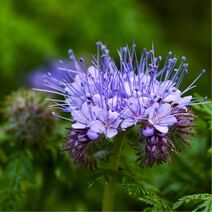Phacelia tanacetifolia
| Phacelia tanacetifolia | |
 | |
| Light: | |
| Moisture: | |
| Soil pH: | 5.6-8.4 |
| Height: | 2' |
| Width: | 1' |
| Blooms: | Mid Summer-Early Fall |
| Native to: | |
| Shelter Nectary | |
| Tea: | Yes |
Phacelia tanacetifolia (common names: fiddleneck and lacy phacelia)
Also called Bee's Friend for good reason; bees love this flower for its abundant nectar, high-quality pollen, and long bloom time. Droves of bees are so energetically attracted to the clustering of light lavender-blue flowers that some suggest coordinating planting times to avoid competing for attention against crops. This flower is also highly attractive to butterflies as well as other beneficial insects such as hoverflies which eat aphids as well as other garden pests.
Propagation: Seed - sow in situ in late spring or late summer. The plant often self-sows.
Cultivation: Succeeds in any moderately fertile well-drained soil in a sunny position[1]. Prefers a moist soil[2].
The flowers are a rich source of nectar and is occasionally grown commercially as a crop for bees[3][4][5].
Range: South-western N. America in California. Often naturalized in Europe[4].
Habitat: Open flats and slopes below 1200 metres[6].
Usage: Used as a green manure crop, but has not as yet (1980) been properly tested in Britain[7]. It is not very deep rooted.
Pollinators: Bees
Soil: Can grow in light, medium, and heavy soils.
Drainage: Prefers well drained soil.
In Leaf: Late Spring-Early Fall
Seed Ripens: Late Summer-Early Fall
Flower Type: Hermaphrodite
Links
References
- ↑ Huxley, Anthony. The New Royal Horticultural Society Dictionary of Gardening. MacMillan Press, 1992.
- ↑ International Bee Research Association. Garden Plants Valuable to Bees. International Bee Research Association, 1981.
- ↑ Uphof, Johannes. Dictionary of Economic Plants. Weinheim, 1959.
- ↑ 4.0 4.1 Tutin, Tom et al.. Flora Europaea. Cambridge University Press, 1964.
- ↑ Usher, George. A Dictionary of Plants Used by Man. Constable, 1974.
- ↑ Munz, David. A California Flora. University of California Press, 1959.
- ↑ Woodward, L and P Burge. Green Manures. Elm Farm Research Centre, 1982.